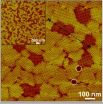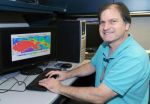(Press-News.org) Magnetically speaking, photons are the mavericks of the engineering world. Lacking electrical charge, they are free to run even in the most intense magnetic fields. But all that may soon change. In a paper published in Nature Photonics, an interdisciplinary team from Stanford University reports that it has created a device that tames the flow of photons with synthetic magnetism.
The process breaks a key law of physics known as the time-reversal symmetry of light and could yield an entirely new class of devices that use light instead of electricity for applications ranging from accelerators and microscopes to speedier on-chip communications.
"This is a fundamentally new way to manipulate light flow. It presents a richness of photon control not seen before," said Shanhui Fan, a professor of electrical engineering at Stanford and senior author of the study.
A DEPARTURE
The ability to use magnetic fields to redirect electrons is a founding principle of electronics, but a corollary for photons had not previously existed. When an electron approaches a magnetic field, it meets resistance and opts to follow the path of least effort, travelling in circular motion around the field. Similarly, this new device sends photons in a circular motion around the synthetic magnetic field.
The Stanford solution capitalizes on recent research into photonic crystals – materials that can confine and release photons. To fashion their device, the team members created a grid of tiny cavities etched in silicon, forming the photonic crystal. By precisely applying electric current to the grid they can control – or "harmonically tune," as the researchers say – the photonic crystal to synthesize magnetism and exert virtual force upon photons. The researchers refer to the synthetic magnetism as an effective magnetic field.
The researchers reported that they were able to alter the radius of a photon's trajectory by varying the electrical current applied to the photonic crystal and by manipulating the speed of the photons as they enter the system. This dual mechanism provides a great degree of precision control over the photons' path, allowing the researchers to steer the light wherever they like.
BROKEN LAWS
In fashioning their device, the team has broken what is known in physics as the time-reversal symmetry of light. Breaking time-reversal symmetry in essence introduces a charge on the photons that reacts to the effective magnetic field the way an electron would to a real magnetic field.
For engineers, it also means that a photon travelling forward will have different properties than when it is traveling backward, the researchers said, and this yields promising technical possibilities. "The breaking of time-reversal symmetry is crucial as it opens up novel ways to control light. We can, for instance, completely prevent light from traveling backward to eliminate reflection," said Fan.
The new device, therefore, solves at least one major drawback of current photonic systems that use fiber optic cables. Photons tend to reverse course in such systems, causing a form of reflective noise known as backscatter.
"Despite their smooth appearance, glass fibers are, photonically speaking, quite rough. This causes a certain amount of backscatter, which degrades performance," said Kejie Fang, a doctoral candidate in the Department of Physics at Stanford and the first author of the study.
In essence, once a photon enters the new device it cannot go back. This quality, the researchers believe, will be key to future applications of the technology as it eliminates disorders such as signal loss common to fiber optics and other light-control mechanisms.
"Our system is a clear direction toward demonstrating on-chip applications of a new type of light-based communication device that solves a number of existing challenges," said Zongfu Yu, a post-doctoral researcher in Shanhui Fan's lab and co-author of the paper. "We're excited to see where it leads."
###
This article was written by Andrew Myers, associate director of communications for the Stanford University School of Engineering.
END
PORTLAND, Ore. — Researchers at Oregon Health & Science University have discovered that blocking a certain enzyme in the brain can help repair the brain damage associated with multiple sclerosis and a range of other neurological disorders.
The discovery could have major implications for multiple sclerosis, complications from premature birth and other disorders and diseases caused by demyelination – a process where the insulation-like sheath surrounding nerve cells in the brain becomes damaged or destroyed. Demyelination disrupts the ability of nerve cells to communicate ...
The 1000 Genomes Project today presents a map of normal human genetic variation – everything from tiny changes in the genetic code to major alterations in our chromosomes. In a DNA version of 'spot-the-difference', EMBL scientists and their colleagues studied the genomes of 1092 healthy people from Europe, the Americas and East Asia, systematically tracking what makes us different from each other. Their results, published in Nature, open new approaches for research on the genetic causes of disease.
"The 1000 Genomes Project has achieved something truly exceptional in ...
AUSTIN, Texas — Since the age of dinosaurs, most species of day-active mammals have retained the imprint of nocturnal life in their eye structures. Humans and other anthropoid primates, such as monkeys and apes, are the only groups that deviate from this pattern, according to a new study from The University of Texas at Austin and Midwestern University.
The findings, published in a forthcoming issue of Proceedings of the Royal Society B, are the first to provide a large-scale body of evidence for the "nocturnal bottleneck theory," which suggests that mammalian sensory ...
URBANA –Many young Jamaican immigrants are succeeding in the United States precisely because they remain strongly tied to Jamaican culture, said University of Illinois professor Gail M. Ferguson.
"Although many of these youths have forged a unique tricultural identity that draws from their Jamaican culture, African-American culture, and mainstream European American culture, the important factor in their academic and behavioral success is retaining strong ties to their Jamaican background," she said.
To learn how Jamaican immigrant teens were adjusting to life in their ...
Proteins are able to self-assemble into a wide range of highly ordered structures that feature a diverse array of properties. Through biomimicry - technological innovation inspired by nature – humans hope to emulate proteins and produce our own version of self-assembling molecules. A key to accomplishing this is understanding how protein-folding – a process critical to the form and function of a protein – is extended from individual proteins to complex assemblies.
Researchers with the U.S. Department of Energy (DOE)'s Lawrence Berkeley National Laboratory (Berkeley Lab) ...
VIDEO:
This animation of satellite imagery shows the life of Hurricane Sandy from its development in the Caribbean Sea on Oct. 21, through its track up the US East coast and...
Click here for more information.
Hurricane Sandy is giving up the ghost on Halloween over Penn. As the storm weakened to a remnant low pressure area the NASA GOES Project released an animation of NOAA's GOES-13 satellite imagery covering Hurricane Sandy's entire life.
The GOES-13 satellite is managed ...
As Hurricane Sandy made a historic landfall on the New Jersey coast during the night of Oct. 29, the Visible Infrared Imaging Radiometer Suite (VIIRS) on NASA/NOAA's Suomi National Polar-orbiting Partnership (NPP) satellite captured this night-time view of the storm. This image provided by University of Wisconsin-Madison is a composite of several satellite passes over North America taken 16 to18 hours before Sandy's landfall.
The storm was captured by a special "day-night band," which detects light in a range of wavelengths from green to near-infrared and uses filtering ...
The mineral properties of the aerosol particles and the wavelength distribution of incident light combine to determine whether a dust particle reflects radiation and cools the local atmosphere, absorbs radiation and warms the local atmosphere, or both. While scientists have a good handle on dust's primary effect of reflecting and cooling at the visible wavelengths, the smaller influence of absorbing and warming at the longer infrared wavelengths has remained more of an uncertainty – and most climate models either underestimate it or do not include it at all.
When the ...
Interventions designed to improve core deficits in children with autism spectrum disorders are supported by varying levels of evidence, highlighting the need for well-designed studies to better evaluate the interventions, according to a new RAND Corporation study.
Researchers found that when they evaluated the past research on a wide variety of interventions aimed at improving core deficits in social/communication, language, behavior and adaptive skills, the evidence of efficacy ranged from moderate to insufficient. The findings are published in the November edition of ...
(Boston) - In the United States, the cost paid for statins (drugs to lower cholesterol) in people under the age of 65 who have private insurance continues to exceed comparable costs paid by the government in the United Kingdom (U.K.) by more than three fold. These results from Boston University's Boston Collaborative Drug Surveillance Program, are a follow up of an ongoing comparison of prescription drug costs between the U.S. and U.K. The initial results reported on relative drug costs in 2005. The current updated results for 2009 appear this week in the journal Pharmacotherapy. ...




